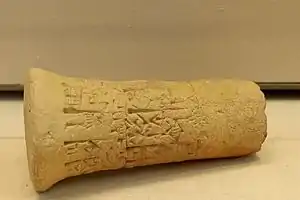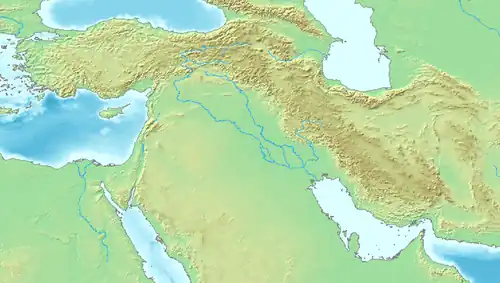| Lugal-kinishe-dudu 𒈗𒆠𒉌𒂠𒌌𒌌 | |
|---|---|
 Foundation nail dedicated by Entemena, king of Lagash, to the god of Bad-Tibira, about the peace treaty concluded between Lagash and Uruk. Extract from the inscription: "Those were the days when Entemena, ruler of Lagash, and Lugal-kinishe-dudu, ruler of Uruk, concluded a treaty of fraternity". This text is the oldest diplomatic document known. Found in Telloh, ancient Girsu, ca. 2400 BC. Louvre Museum.[1] | |
| Reign | c. 2400 BCE |
| Predecessor | Urzage[2] |
| Successor | Lugal-kisal-si |
| Dynasty | Second Dynasty of Uruk |
Lugal-kinishe-dudu (𒈗𒆠𒉌𒂠𒌌𒌌, lugal-ki-ni-še₃-du₇-du₇)[5] also Lugal-kiginne-dudu (𒈗𒆠𒁺𒉌𒌌𒌌, lugal-ki-gin-ne2-du₇-du₇),[6] was a King and (ensi) of Uruk and Ur who lived towards the end of the 25th century BCE.[7] The Sumerian King List mentions Lugal-kinishe-dudu as the second king of the dynasty after En-shakansha-ana, attributing to him a fanciful reign of 120 years.[7][8]
The inscriptions of this sovereign which have been discovered show that he retained the power inherited from his predecessor, since he proclaimed himself king of Ur and Kish:[9]
"For An, king of all the lands, and for Inanna, mistress of Eanna. Lugalkiginnedudu, the king of Kish. When Inana gave to Lugalkiginnedudu en-ship in addition to kingship, she allowed him to exercise en-ship in Uruk, and she allowed him to exercise kingship in Ur."
Numerous fragments are known that bear the name of Lugalkinishedudu, mainly found in Nippur, and now located in the University of Pennsylvania Museum of Archaeology and Anthropology.[12]
The most remarkable document in which he is mentioned is a clay nail found in Girsu and commemorating the alliance which he concluded with Entemena of Lagash, the oldest known reference to a peace treaty between two kings:[7][13]
Cone of Entemena mentioning the alliance with Lugal-kinishe-dudu1st line:
Dinanna-ra / Dlugal-e2-muš3-ra / en-mete-na / ensi2 / lagaški-ke4 / e2-muš3 e2 ki-ag2-ga2-ne-ne / mu-ne-du3 / KIBgunû mu-na-du11 / en-mete-na / lu2 e2-muš3 du3-a
2nd line:
D-ra-ni / dšul-utul12-am6 / u4-ba en-mete-na / ensi2 / lagaški / lugal-ki-ne2-eš2-du7-du7 / ensi2 / unuki-bi / nam-šeš e-ak1st line:
"For Inanna / and Lugal-emuš / Enmetena / ruler / of Lagaš, / the E-muš, their beloved temple, / built / and ordered (these) clay nails for them. / Enmetena, / who built the E-muš,"
2nd line:
"his personal god / is Šul-utul. / At that time, Enmetena, / ruler / of Lagaš, / and Lugal-kineš-dudu, / ruler / of Uruk, / established brotherhood."— Alliance treaty between Entemana and Lugal-kinishe-dudu.[13]
He was followed by his son, Lugalkisalsi, also read Lugaltarsi.[7]
 Lugal-kisalsi was the son of Lugal-kinishe-dudu
Lugal-kisalsi was the son of Lugal-kinishe-dudu The name "Lugal-kinishe-dudu" on the Treaty Cone of Entemena. British Museum
The name "Lugal-kinishe-dudu" on the Treaty Cone of Entemena. British Museum "Lugal-kinishe-dudu / King of Uruk /King of Ur" on the vase inscription
"Lugal-kinishe-dudu / King of Uruk /King of Ur" on the vase inscription
See also
References
- ↑ "Louvre Museum Official Website". cartelen.louvre.fr.
- ↑ Marchesi, Gianni (January 2015). "Toward a Chronology of Early Dynastic Rulers in Mesopotamia". In W. Sallaberger and I. Schrakamp (Eds.), History & Philology (ARCANE 3; Turnhout), Pp. 139-156.
- ↑ Clay, Albert Tobias; Hilprecht, H. V. (Hermann Vollrat); Myhrman, David Vilhelm; Poebel, Arno; Ranke, Hermann; Radau, Hugo; Langdon, Stephen (1892). The Babylonian Expedition of the University of Pennsylvania. Series A: Cuneiform texts. Philadelphia : Dept. of Archaeology, University of Pennsylvania. pp. Transcriptions 86–87.
- ↑ "CDLI-Archival View". cdli.ucla.edu.
- ↑ "Sumerian Dictionary". oracc.iaas.upenn.edu.
- ↑ MAEDA, TOHRU. KING OF KISH" IN PRE-SAROGONIC SUMER. p. 4.
- 1 2 3 4 Hayes, William (1950). Chronology. Cambridge Ancient History. p. 51.
- ↑ "In Unug, En-shakansha-ana became king; he ruled for 60 years. Lugal-ure (ms. P3+BT14 has instead: Lugal-kinishe-dudu (?)) ruled for 120 years. Argandea ruled for 7 years. (ms. L1+N1 has:) 3 kings; they ruled for (ms. L1+N1 has:) 187 years. Then Unug was defeated (ms. TL has instead: destroyed) and the kingship was taken to Urim." in "The Sumerian king list: translation". etcsl.orinst.ox.ac.uk.
- ↑ Centre, Copenhagen Polis (2002). A Comparative Study of Six City-state Cultures: An Investigation. Kgl. Danske Videnskabernes Selskab. p. 34. ISBN 978-87-7876-316-7.
- ↑ MAEDA, TOHRU (1981). "KING OF KISH" IN PRE-SARGONIC SUMER. Orient: The Reports of the Society for Near Eastern Studies in Japan, Volume 17. p. 7.
- ↑ "CDLI-Archival View". cdli.ucla.edu.
- ↑ CDLI-Found Texts.
- 1 2 Deena Ragavan, Cuneiform Texts and Fragments in the Harvard Art Museum / Arthur M. Sackler Museum, Cuneiform Digital Library Journal, vol. 2010:1, ISSN 1540-8779



